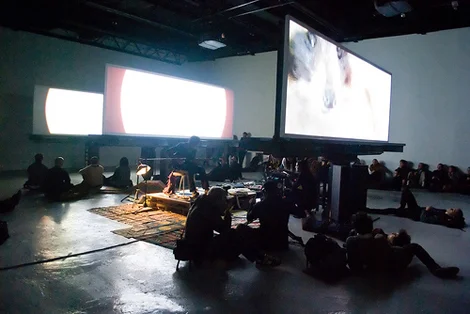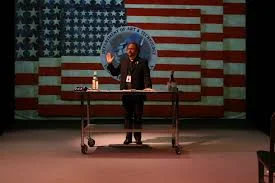Migration
image from http://www.dougaitkenworkshop.com/work/migration/
Migration is an art video installation created by Doug Aitken. It consists of three large screens and they are placed in a row. In the performance, these screens are displaying the same video but not in the same timeline, there is a delay of a few seconds in the second and third screens. Audiences can watch three scenes at the same time and the delays in each screen make the performance more dynamic and impressive.
The video in the installation is about the “migrations” of many wild animals. At the beginning, there is a horse locked in a room and the television behind it is displaying a black and white scene of many horses running in wild spaces. The black and white represents the old times and memories of this horse, but it can no longer get back. It is now suffering the pain being alone and limitation of freedom. In addition to the horse, there are many more scenes about other animals, like buffalo, owls, deer and etc. All of them are trapped in modern constructions. They are drinking water from swimming pool, taking shower in bathroom, everything that they could never have done in nature environment. But, none of them seems pleased to live far away from nature. This video tells a sad story that wild animals are losing their living spaces because human beings abuse the environment. They have no places to live so they have to migrate to human places. By showing the sad situations of wild animals, The artist is describing his hope that humans can help protect the animals and stop violating their living spaces.
Hans Michaud describes “Migration” in Whitehot Magazine:
“Doug Aitken's piece, Migration, is by all means a gallery piece, even though a staggering number of elements (music, lighting, editing, etc.)arrive here from the cinema. From Migration, what I as a viewer/gallery-attendee have gathered from the work is as best as I can describe it, something like the following:
-a series of vignettes, gathered together and presented on more than one screen nearly simultaneously (staggered slightly), using very discrete elements out of their natural or expected contexts so as to present a set of inquiries, aimed at both familiarizing and destabilizing the viewer.” Hans Michaud. http://whitehotmagazine.com/articles/2008-doug-aitken-303-gallery/1644
images from http://www.dougaitkenworkshop.com/work/song1/
Another piece of Doug Aitken’s work is called Song1 (http://www.dougaitkenworkshop.com/work/song1/). Installation is placed around courtesy Museum and Sculpture Garden. Different from what he did in some other museum video art, Song 1 is a projection show around the museum in 360 degrees, along with a lot of different music clips. The installation uses the construction as the platform of the art video so that all people in this area have the opportunity to watch this video.
In Cecilia Lopez’s video installation(https://www.youtube.com/watch?v=bL37d53WE-s), he also creates a 3-channel video installation, but differently, he put these 3 channels in the different orders. These 3 channels work together and give audience an immediate sense of traveling in space or some other future places. Doug Aitken’s installation makes the audience feel the space a lot and also makes the video more dynamic while Cecilia Lopez’s installation helps create an immediate feeling of traveling in space.
Places that the work has been shown at:
303 gallery, New York
547 West 21st Street, Manhattan
525 West 22nd Street Chelsea
Resources from:
http://query.nytimes.com/gst/fullpage.html?res=990DE6DE123AF934A25753C1A96E9C8B63
Other relevant images:
image from http://www.dougaitkenworkshop.com/work/migration/
image from http://www.dougaitkenworkshop.com/work/migration/










